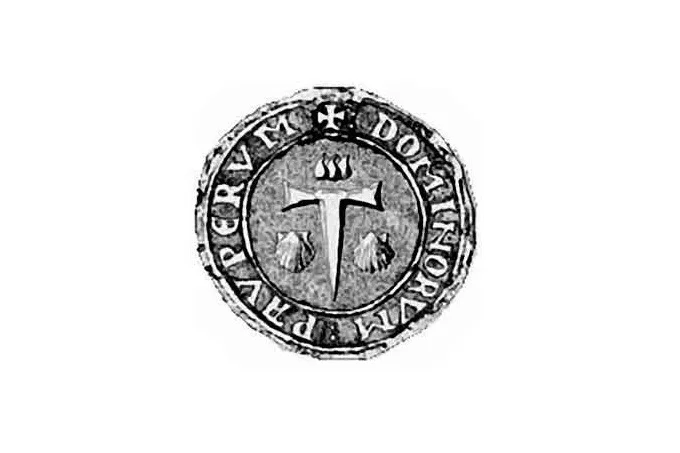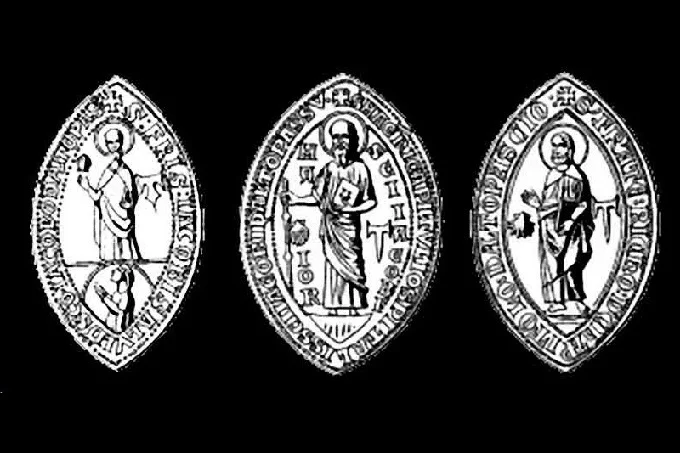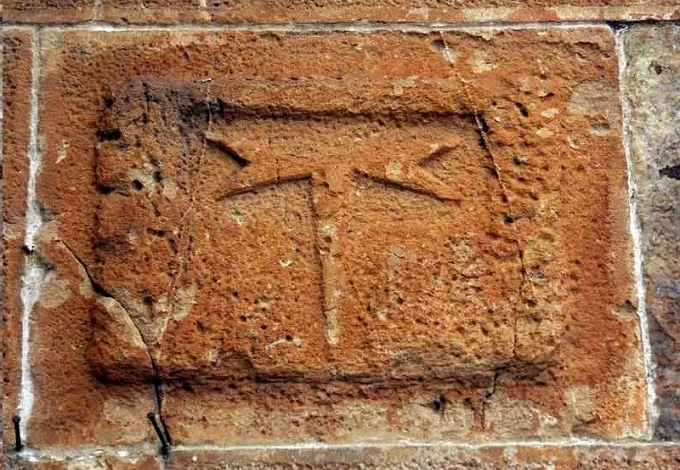Knights of the Order of Tau: the predecessors of the Templars

In the Middle Ages, the ancient Italian city of Lucca played the same role as the Palestinian Jaffa. While the latter was the connection between the pilgrims’ routes to Jerusalem, Lucca was the connection between the roads to Rome, Parma, Pisa, Florence, and the seaports of Apulia. The main transport artery of the time, the Via Francigena, passed through the city. Through it, but in the opposite direction, the pilgrims went to another equally famous and important shrine, the Iberian Santiago de Compostela.
The small town of Altopascio near Lucca was part of the infrastructure of this vast tract, providing pilgrims with temporary shelter and sustenance. The pilgrimage to the holy places was by no means safe. No one knew who had more courage: the knights, alone, to fight Saracen crowds, or the pilgrims, unarmed, who set out into the distance knowing that hunger, cold, disease, and… bandits awaited them on the way.
Bloodthirsty and ruthless, who sent good Christians to their deaths with terrifying ease. The church was deprived of the financial influx brought by the crowds of pilgrims. Moreover, people were losing faith and hope in the intercession of the saints, since they could not ensure their safety even on their way to them. This was more than a financial loss.
Since the tenth century, this problem has been tried. Numerous religious and secular communities emerged, setting as their main task the protection of pilgrims. They added medical aid to military aid. Hospitals or hospices thus appeared. At first, there was no regulation for this activity, and its scope was clearly local and poorly documented.
And so, in the early XI century in Altopasho was founded by the Order of the Knights Hospital of the Tau. The date of its founding is uncertain, but on August 2, 1084, this Order already receives as a gift a certain hospice located in loco et finibus ubi dicitur Teupascio [“in a place called Teupascio”]. The name comes from the emblem of the Order in the form of the letter tau. This insignia can still be seen in Altopascio on the bell tower of St. James Church.
The city became their headquarters. The sign has a vertical pointed end, which, according to some researchers, resembles the nail of the Passion of the Lord, and according to others, a pilgrim’s staff. To get the latest stories, install our app here.
By the way, the sign of the Tau more corresponds to the kind of crucifixion instrument used in the time of Christ than to the cross. The same spike can be seen later on the seals of some masters of the Templar Order. The seals of the Order of the Tau, in addition to the sign itself, bear images of shells. This, too, is one of the symbols of pilgrimage. Such shells were collected by pilgrims on the way of Santiago. The Tau was also used in its symbolism by the Fraternity of St. Anthony’s Hospital and the Franciscans.

There is documentary evidence from which we can conclude that before the Order became a martial order, it already existed as a hospice. This is evident from the bull of Pope Anastasius IV of 1154, in which he mentions some tithes granted to the hospital of Altopaso by Bishop Anselm, who governed the diocese of Lucca from 1073 to 1081. All this is reminiscent of the history of the founding of the Hospitaller Order in Jerusalem.
To the question of the founders of the Order. Their names are unknown, but oral tradition attributes it to a group of twelve knights from Lucca. The number twelve should probably be understood purely symbolically, according to the number of disciples of Christ. Such a motif was often used in the founding of churches, hospitals, and orphanages. The hospital of Altopacho was dedicated to St. James, who became the protector of the Order. He was soon joined by Saints Eligius and Christopher, also considered patrons of pilgrims.
Some scholars believe that the famous Matilda of Canossa – a faithful friend and collaborator of Pope Gregory VII in his struggle for investiture – had a hand in the creation of the Order. Almost the only woman of that period who personally led the military action. The only other such woman was probably Joan of Arc.
Surprisingly, this Order received its charter only in 1239 by Order of Pope Gregory IX. So to speak, retroactively. It was based on the charter of their fellow Jerusalem Hospitallers and included 96 articles. Like all similar charters, it clearly regulated all aspects of the Order.
The Order’s members were divided into lay brothers, priest brothers, deacons, subdeacons, clerics, and knight brothers; the Order was among the first to admit women into its ranks, with the condition that they live apart from the brothers. To get the latest stories, install our app here.
Their official uniform consisted of a cassock and a dark cloak over which a white tau cross was sewn. Knights were allowed to carry a sword solely for the task of protecting pilgrims. The Grand Master remained in office for life. He was elected by a committee of twelve monks, who in turn were elected by a committee of three: a prior of the church, a brother knight, and a brother layman.

Assistance to pilgrims and hospitality were equally strictly regulated. Four physicians and two lay surgeons were kept for these purposes [monks were not allowed to practice surgery]. The specialists were carefully selected, so that they were able to cope with the most common illnesses and emergencies that occurred to travelers at the time. Such as all kinds of wounds, sores, and fractures.
The Order grew rapidly, receiving more and more donations and privileges. Between the eleventh and twelfth centuries it already possessed a large number of estates throughout Italy, in areas crossed by the Via Francigena. Most of them were in Tuscany, between Lucca, Prato, Pistoia, Pisa, and Volterra.
Soon the fame of the Order crossed the borders of Italy – in 1180, a house was established in Paris, not far from the city walls [now rue Saint-Jacques]. Today, the church of Saint-Jacques-du-Pa is located on that site. The Order also had branches in Spain [in Astorga, Pamplona, and Tortosa], Germany and England.
The Order of the Knights of the Tau reached the peak of its development and wealth in the thirteenth century, after which a slow but inexorable decline began in the following century. In part, this was due to the loss of importance of the Via Francigena, which occurred when the papal seat was moved to Avignon, which led to a reduction in the intensity of pilgrimages to Rome.
The decisive blow was dealt by the internal wars that broke out in Tuscany between Pisa, Lucca, and Florence. As a result, Altopascio, the main seat of the Order, became the center of the theater of war. When Florence finally gained the upper hand in 1339, destroying the importance of the Via Francigena, the Order lost its significance. But still, it existed until 1587, when it was dissolved by Pope Sixtus V. Its property was transferred to the Order of St. Stephen, created by that time in Tuscany by the Duke of Medici.
In studying the history of this Order, one strange thing can be noticed – the Order was indifferent to the Holy Land. In fact – these Knights of the Tau could have successfully carried out their duties on the roads to Jerusalem even before the Templars. After all, by then, they were already quite an independent fighting unit. And they were just as capable of providing oddball services as their Amalfi counterparts. Was Santiago de Compostela, in the eyes of these knights, more important than the Church of the Holy Sepulchre?
Although maybe there is no strangeness and the founding community of the Knights Templar Order is just a Palestinian branch of the Order of the Tau? By the way, the Italians believe that Hugo de Paine was from the Campania region of southern Italy. And his name was Hugo de Pagani. In support of this version speaks a letter written by the Master Templar from Paletina to his father in the Italian Nocera de Pagani, dated 1103.
So the mystery of the first Templars remains unsolved. But that the Knights of the Tau were their predecessors is beyond doubt. To get the latest stories, install our app here.




